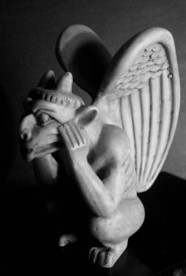That's all very well, you might wonder, but why the Golliwogg? After all, Marc Singer can cope with the change in the book's tone at the point when Mina and Allan need rescuing, and can understand why Moore feels a need to introduce an outlandish character from children's literature to save the day, but cannot understand why Moore and O'Neill have opted for a figure so many are bound to regard as a racist stereotype.
Apparently it was O'Neill who introduced Moore to the character a few years back; Moore would naturally have been familiar the Golliwog dolls so popular during his childhood, but was evidently unaware, as was I until I looked it up, of Florence Kate Upton's book The Adventures of the Two Dutch Girls and a Golliwogg. Moore was immediately intrigued by the character, and said he'd surely find a place in League, and indeed true to his word the Golliwogg was first alluded to on the last page of the 'Almanac' in League Volume II. The 'Almanac' has Mina reporting that Olympia, the Queen of Toyland, said that Toyland was occasionally visited by someone she described as a 'bold, fearless black balloonist,' an explorer she thought they might well be advised to meet.
It's striking that Moore's Golliwogg does not live in Toyland -- striking because he is, after all, a doll. Indeed, in a passage within the Dossier's final section describes his skin as being 'matt black' and textured in a way that did not permit even expected normal highlights and reflections. The simplest explanation for this is that the Golliwogg is, traditionally, a doll. In League matters are a little more complex, as Mina refers to him living in a 'black-material cosmos', 'black material' presumably being dark matter.
Enid Blyton followed Upton by using the Golliwogg, by this point spelling the word Golliwog, in her 'Noddy' books, all set in Toyland, and I think this is of crucial thematic significance for the character's symbolic value in this world. If you pick up any recent edition of any Noddy book you'll not find a hint of a Golliwog in it; the Golliwog, recognised as a racist caricature, has been written out of the story. Granted, the reasons for doing this are certainly not bad ones, but whatever you think of this what's indisputable is that for reasons of political correctness, the Golliwog is unacceptable in Toyland.
In terms of the overall thrust of Black Dossier, then, it's clear that the Golliwogg has become the great 'Unperson' of children's literature. It seems to me entirely fitting that this supreme 'unperson' should appear at the critical moment, rescuing the fugitives and ferrying them to their arctic asylum, from where the war against the forces of repression and the mundane can be planned.
Apparently it was O'Neill who introduced Moore to the character a few years back; Moore would naturally have been familiar the Golliwog dolls so popular during his childhood, but was evidently unaware, as was I until I looked it up, of Florence Kate Upton's book The Adventures of the Two Dutch Girls and a Golliwogg. Moore was immediately intrigued by the character, and said he'd surely find a place in League, and indeed true to his word the Golliwogg was first alluded to on the last page of the 'Almanac' in League Volume II. The 'Almanac' has Mina reporting that Olympia, the Queen of Toyland, said that Toyland was occasionally visited by someone she described as a 'bold, fearless black balloonist,' an explorer she thought they might well be advised to meet.
It's striking that Moore's Golliwogg does not live in Toyland -- striking because he is, after all, a doll. Indeed, in a passage within the Dossier's final section describes his skin as being 'matt black' and textured in a way that did not permit even expected normal highlights and reflections. The simplest explanation for this is that the Golliwogg is, traditionally, a doll. In League matters are a little more complex, as Mina refers to him living in a 'black-material cosmos', 'black material' presumably being dark matter.
Enid Blyton followed Upton by using the Golliwogg, by this point spelling the word Golliwog, in her 'Noddy' books, all set in Toyland, and I think this is of crucial thematic significance for the character's symbolic value in this world. If you pick up any recent edition of any Noddy book you'll not find a hint of a Golliwog in it; the Golliwog, recognised as a racist caricature, has been written out of the story. Granted, the reasons for doing this are certainly not bad ones, but whatever you think of this what's indisputable is that for reasons of political correctness, the Golliwog is unacceptable in Toyland.
In terms of the overall thrust of Black Dossier, then, it's clear that the Golliwogg has become the great 'Unperson' of children's literature. It seems to me entirely fitting that this supreme 'unperson' should appear at the critical moment, rescuing the fugitives and ferrying them to their arctic asylum, from where the war against the forces of repression and the mundane can be planned.

No comments:
Post a Comment